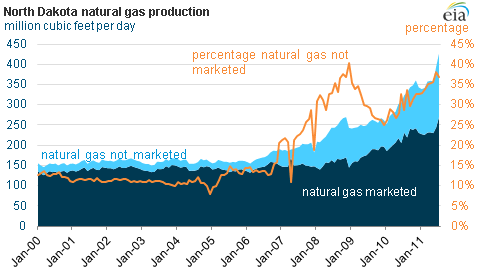
Posted on 04/09/2012 12:34:17 PM PDT by thackney
The number natural gas flaring permits issued in Texas has more than quadrupled over the past two years, as oil and gas production in the state has boomed, according to the Texas Railroad Commission.
The state commission issued 651 permits last year, compared to 306 in 2010. In 2009, 158 permits were handed out.
Companies flare, or burn off, natural gas produced from their wells if low prices make the fossil fuel uneconomical to sell or if there’s not enough pipeline capacity to get to it market. Flaring also occurs to relieve dangerous pressure levels in wells and for other safety reasons.
The rapid increase in gas flaring is even more pronounced in North Dakota, where more than one-third of the fossil fuel is going up in smoke, according to the U.S. Energy Information Administration.
A group of institutional investors recently released a letter to 21 oil and gas companies decrying the rise of flaring because of the environmental and financial impacts. The group specifically called out Texas and North Dakota for the problem.
“We are concerned that flaring of natural gas wastes a valuable product,” the letter reads. “Even at today’s depressed wellhead price, the 100 million cubic feet of natural gas that were flared each day in North Dakota last year represents approximately $110 million in lost revenue.”
The letter, which was sent to leaders of Anadarko, Apache, ExxonMobil, Marathon Oil, Chesapeake Energy, Noble Energy and other major producers, pointed to the proliferation of shale oil production as a key driver for flaring’s growth.
Ramona Nye, spokeswoman for the Texas Railroad Commission, says most of the flared gas in Texas comes from oil wells, where it is produced as a byproduct. While natural gas production has slowed because of its low price, oil drilling has boomed in Texas and across the country in recent years.

Cheniere to Develop LNG Export Terminal at Corpus Christi
Friday, December 16, 2011
I think many of our LNG import terminals are going to become export terminals.
That looks like....a hockey stick...
Srikes me as criminal wastage. This vitally important resource is not being “produced;” it is being released or extracted. It is bad enough that huge amounts of this gas, and petroleum, are used to make plastics (landfill stuffers)and fertilizers.
BTW, can any Freeper direct me to scientific publications that explain a process that could result in the production and the locational concentration of deposits of petroleum?
I don’t think it is going to last.
Natural gas flaring regulations:
According to current North Dakota state regulations, producers can flare natural gas for one year without paying taxes or royalties on it, and can ask for an extension on that period due to economic hardship of connecting the well to a natural gas pipeline. After one year, or when the extension runs out, producers can continue flaring but are responsible for the same taxes and royalties they would have paid if the natural gas went to market.
Can you explain more what you are looking for?
You talk about a process for production and for locational concentration of deposits?
Oil and gas are always sourced to sedimentary basins. Does that help?

Gas-to-liquid technology is very unlikely to work at the well location. You need a clean source of gas, after the gas processing plant.
Wellhead gas contains varying amounts of CO2, H2S, water, Natural Gas Liquids, etc.
If it was piped up to a gas processing plant, this would no longer be an issue.
Here is a new GTL process but I havent been able to find much on it so it may just be a pie in the sky.
http://www.bizjournals.com/albuquerque/stories/2007/04/09/story5.html
So they have to pay taxes on it, even if they would lose money bringing it to market. Wow...only government could come up with something so stupid.
Didn’t know that. Thanks.
Exactly.If the stories I've read are true the US and Canada both have obscene quantities of gas in reserve.Assuming that's true there's gotta be a way to use it for our benefit.


Royalties as well I suspect.
That is what shut down a lot of gas flaring in many areas, including the Alaska North Slope.
Are the royalties and taxes the same for gas and oil?
“If it was piped up to a gas processing plant, this would no longer be an issue.”
Which brings back to the orginal problem that there are no pipelines. Depending on the gas perhaps processing of of the unwanted products could also be done on a small scale in the field. I understand that there would be a lot of variables as to if it would be feasable in a particular field or not.
I don't think so. I've done work for a samll and large gas processing facility. Separating out the other components requires you to do something with almost all of the components. And the smaller the processing equipment, the less efficient that typically becomes. They require energy themselves. It would be just as more cost effective to run some low pressure HDPE pipe as to bring in electrical power lines and the scatter around processing equipment.
The royalty rates are likely the same, percentage basis. The taxes I’m guessing would likely be lower for Natural Gas.
Disclaimer: Opinions posted on Free Republic are those of the individual posters and do not necessarily represent the opinion of Free Republic or its management. All materials posted herein are protected by copyright law and the exemption for fair use of copyrighted works.